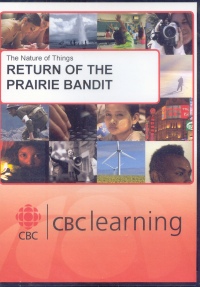| ________________
CM . . .
. Volume XVIII Number 29. . . .March 30, 2012 
 |
Return of the Prairie Bandit. (The Nature of Things).
Toronto, ON: CBC Learning (www.cbclearning.ca), 2010.
45 min., DVD, $60.00 (Single site license price).
Product ID ZZY-10-17.
Grades 5 and up / Ages 10 and up.
Review by Gillian Richardson.
**** /4
|
| |
|

Habitat loss, over-hunting and/or climate change: these factors are usually responsible for altering an ecosystem to the point where an animal species becomes endangered, extinct or extirpated. In the case of the black-footed ferret, all three factors have played a role. This "Nature of Things" documentary describes the efforts being made to return this mammal to its former habitat after its unfortunate disappearance from the Saskatchewan prairie (last seen in 1937) and near extinction in the wild.
The black-footed ferret population was reduced to a low of 18 animals in the 1980s in the US before breeding programs in zoos began to restore its numbers (now 1000 in the wild, and 300 in captivity). Its demise is tied directly to the dramatic decline of black-tailed prairie dogs which are the sole food source for this specialist predator. The prairie dogs were the object of an historic extermination effort by prairie settlers. Droughts and plagues further decimated their numbers.
The DVD considers re-introduction challenges faced by ferret tracker and scientific consultant Travis Livieri and his team in Grasslands National Park, southwestern Saskatchewan, in 2009. After a fall release of 34 captive-bred ferrets in this protected environment, the biologists had to track them at night with high-powered lights that pick up eye-shine. Night-vision cameras were set up to monitor nocturnal activity around ferret burrows. The solitary ferrets must outwit coyotes, badgers, owls and hawks while hunting their prey, and must find a mate among their scattered population. Implanted with microchips before release, some of the ferrets' fates could be determined by scanning owl pellets. The recovery team discovered an unexpected barrier during the first winter after the release: hibernating prairie dog burrows plugged with ice as a defense against the bitter cold of the harsh climate.
The DVD discusses another threat to the ferret: bubonic plague. If this disease becomes rampant within the prairie dog colonies, it can be transmitted to the ferret population as well. The defenses include insecticidal dusting to kill fleas (used reluctantly since it can severely affect biodiversity), and vaccination. The team is seen at work capturing the few young born to the released ferrets in spring to examine and inoculate them.
The DVD also contains short profiles of three other endangered species – bison, burrowing owls, greater short-horned lizard – which have benefitted from reintroduction programs in Grasslands National Park.
The viewer is able to witness amazing visuals of the depths of a prairie dog burrow, is taken along on night tracking of the ferrets, allowed to see the ferrets' hunting method of digging for their prey, the kits play-fighting to learn hunting skills, and the engaging 'happy dance' of newly released ferrets. Commentary is provided by Travis Livieri and other biologists involved in the project, including their spontaneous responses to hard-won sighting of their subjects. Frequent scenes of the grassland habitat allow the viewer to get a good sense of the setting, and the challenges inherent in this undertaking.
A 40-page Teacher Resource Guide designed to meet Canadian science curriculum expectations for junior/intermediate grades is available for this DVD documentary. It offers extensive activities and reproducible worksheets to aid in understanding not only the specific details surrounding the reintroduction of the ferret, but also to extend knowledge about habitats and ecosystems that can be applied to other endangered species in Canada. The guide focuses on basic concepts, skills of investigation, science, technology, society and environment, and attitudes.
This DVD and guide package will be a valuable tool for teachers to raise awareness of students to the far-reaching effects of changes and interference on ecosystems.
Highly Recommended.
Gillian Richardson is a freelance writer living in BC.

To comment
on this title or this review, send mail to cm@umanitoba.ca.
Copyright © the Manitoba Library Association. Reproduction for personal
use is permitted only if this copyright notice is maintained. Any
other reproduction is prohibited without permission.
NEXT REVIEW |
TABLE OF CONTENTS FOR THIS ISSUE
- March 30, 2012.
AUTHORS |
TITLES |
MEDIA REVIEWS |
PROFILES |
BACK ISSUES |
SEARCH |
CMARCHIVE |
HOME |
